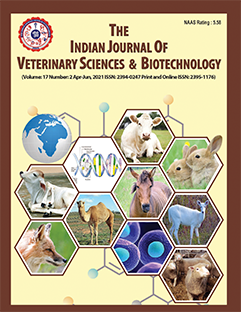Chemoprotective Effect of Eugenol against Single Dose Doxorubicin (DOX)-Induced Toxicopathological Alterations in Swiss Albino Mice with Special Reference to Cardiotoxicity
DOI:
https://doi.org/10.48165/ijvsbt.21.5.21Keywords:
Doxorubicin, Eugenol, Nitric oxide, Acute cardiotoxicityAbstract
Doxorubicin (DOX), is utilized in the treatment of various canine and feline cancers. However, its therapeutic application is associated with marked adverse effects on heart as well as myelosuppression and potential for secondary malignancy. In order to reduce the side effects, potential of eugenol was investigated against Doxorubicin in Swiss albino mice. Toxicity was induced by a single intraperitoneal injection of doxorubicin (25 mg/kg, b.wt.) and Eugenol treatment (10 mg/kg/day, orally) was initiated 15 days before doxorubicin administration. Oral administration of eugenol markedly alleviated DOX-induced oxidative stress in cardiac tissues, as evidenced by reduced levels of lipid peroxidation, nitric oxide. Furthermore, eugenol enhanced the activity of antioxidant enzymes, including catalase and superoxide dismutase. In addition to attenuating oxidative stress, eugenol administration significantly reduced DOX-induced inflammation by downregulating the gene expression of pro-inflammatory mediators, namely, TNF alpha, iNOS and IL. Gross and histopathological examinations revealed substantial structural and functional impairment in the heart, brain, liver, spleen, bone marrow and kidney due to DOX intoxication. This study suggests the promising chemoprotective efficacy of eugenol against DOX-induced toxicopathological alterations, indicating its potential as an adjuvant in chemotherapy.
Downloads
References
Abdeldaim, M.M., Kilany, O.E., Khalifa, H.A., & Ahmed, A.A. (2017). Allicin ameliorates doxorubicin-induced cardiotoxicity in rats via suppression of oxidative stress, inflammation and apoptosis. Cancer Chemotherapy and Pharmacology, 80, 745–753.
Aebi, H. (1984). Catalase in vitro. In: Methods in Enzymology (pp. 121–126). Academic Press.
Aprotosoaie, A.C., Luca, V.S., Trifan, A., & Miron, A. (2019). Antigenotoxic potential of some dietary non-phenolic phytochemicals. Studies in Natural Product Chemistry, 60, 223–297.
Borroto, J.I.G., Creus, A., Marcos, R., Molla, R., & Zapatero, J. (2003). The mutagenic potential of the furylethylene derivative 2-furyl 1-nitroethene in the mouse bone marrow micronucleus test. Toxicological Sciences, 72, 359–362.
Farag, M.R., Moselhy, A.A.A., El-Mleeh, A., Aljuaydi, S.H., Ismail, T.A., Di Cerbo, A., Crescenzo, G., & Abou-Zeid, S.M. (2021). Quercetin alleviates the immunotoxic impact mediated by oxidative stress and inflammation induced by doxorubicin exposure in rats. Antioxidants, 10(12), 1906.
Fouad, A.A., & Yacoubi, M.T. (2010). Mechanisms underlying the protective effect of eugenol in rats with acute doxorubicin cardiotoxicity. Archives of Pharmacal Research, 34(5), 821–828.
Gardner, H.L., Fenger, J.M., & London, C.A. (2016). Dogs as a model for cancer. Annual Review of Animal Bioscience, 4, 199–222.
Hajra, S., Patra, A.R., Basu, A., & Bhattacharya, S. (2018). Prevention of doxorubicin (DOX)-induced genotoxicity and cardiotoxicity: Effect of plant derived small molecule indole-3-carbinol (I3C) on oxidative stress and inflammation. Biomedicine & Pharmacotherapy, 101, 228–243.
Jagetia, G.C., & Venkatesh, P. (2015). An indigenous plant Bael (Aegle marmelos (L.) Correa) extract protects against the doxorubicin induced cardiotoxicity in mice. Journal of Physiology and Biochemistry, 4, 163.
Kumar, A., Siddiqi, N.J., Alrashood, S.T., Khan, H.A., Dubey, A., & Sharma, B. (2021). Protective effect of eugenol on hepatic inflammation and oxidative stress induced by cadmium in male rats. Biomedicine & Pharmacotherapy, 139, 111588.
Li, L., Pan, Q., Han, W., Liu, Z., Li, L., & Hu, X. (2007). Schisandrin B prevents doxorubicin-induced cardiotoxicity via enhancing glutathione redox cycling. Clinical Cancer Research, 15(13), 6753–6760.
Madesh, M., & Balasubramanian, K.A. (1998). Microtiter plate assay for superoxide dismutase using MTT reduction by superoxide. Indian Journal of Biochemistry & Biophysics, 35(3), 184–188.
Magalhaes, C.B., Casquilho, N.V., Machado, M.N., Riva, D.R., Travassos, L.H., Leal-Cardoso, J.H., & Zin, W.A. (2019). The anti-inflammatory and anti-oxidative actions of eugenol improve lipopolysaccharide-induced lung injury. Respiratory Physiology & Neurobiology, 259, 30–36.
Rawat, P.S., Jaiswal, A., Khurana, A., Bhatti, J.S., & Navik, U. (2021). Doxorubicin-induced cardiotoxicity: An update on the molecular mechanism and novel therapeutic strategies for effective management. Biomedicine & Pharmacotherapy, 139, 111708.
Renu, K., Pureti, L.P., Vellingiri, B., & Valsala Gopalakrishnan, A. (2022). Toxic effects and molecular mechanism of doxorubicin on different organs – an update. Toxin Reviews, 41(2), 650–674.
Shafiq-Ur-Rehman. (1984). Lead-induced regional lipid peroxidation in brain. Toxicology Letters, 21(3), 333–337.
Titheradge, M.A. (1998). The enzymatic measurement of nitrate and nitrite. Methods in Molecular Biology, 100, 83–91.
Todorova, K., Dimitrov, P., Milcheva, R., Roga, S., & Russev, R. (2016). Comparative study of several cases of human breast cancer and mammary cancer in domestic dogs and cats. Acta Morphologica et Anthropologica, 23, 66–70.
Ulanowska, M., & Olas, B. (2021). Biological properties and prospects for the application of eugenol – A review. International Journal of Molecular Sciences, 22(7), 3671.
Venkatesh, P., Shantala, B., Jagetia, G.C., Rao, K.K., & Baliga, M.S. (2007). Modulation of doxorubicin-induced genotoxicity by Aegle marmelos in mouse bone marrow: A micronucleus study. Integrative Cancer Therapies, 6(1), 42–53.
Zeiss, C.J., Gatti, D.M., Toro-Salazar, O., Davis, C., Lutz, C.M., Spinale, F., & Churchill, G.A. (2019). Doxorubicin-induced cardiotoxicity in collaborative cross (CC) mice recapitulates individual cardiotoxicity in humans. G3: Genes, Genomes, Genetics, 9(8), 2637–2646.
Zhao, P., Zhou, W., Zhang, Y., Li, J., Zhao, Y., Pan, L., & Hui, J. (2020). Aminooxyacetic acid attenuates post‐infarct cardiac dysfunction by balancing macrophage polarization through modulating macrophage metabolism in mice. Journal of Cellular and Molecular Medicine, 24(4), 2593–2609.
Zhu, Y., Chen, X., Guo, L., Wang, L., Chen, N., Xiao, Y., & Wang, E. (2022). Acute sleep deprivation increases inflammation and aggravates heart failure after myocardial infarction. Journal of Sleep Research, 31(6), 13679.
Downloads
Published
Issue
Section
License
Copyright (c) 2025 Indian Journal of Veterinary Sciences and Biotechnology

This work is licensed under a Creative Commons Attribution-NonCommercial-NoDerivatives 4.0 International License.




